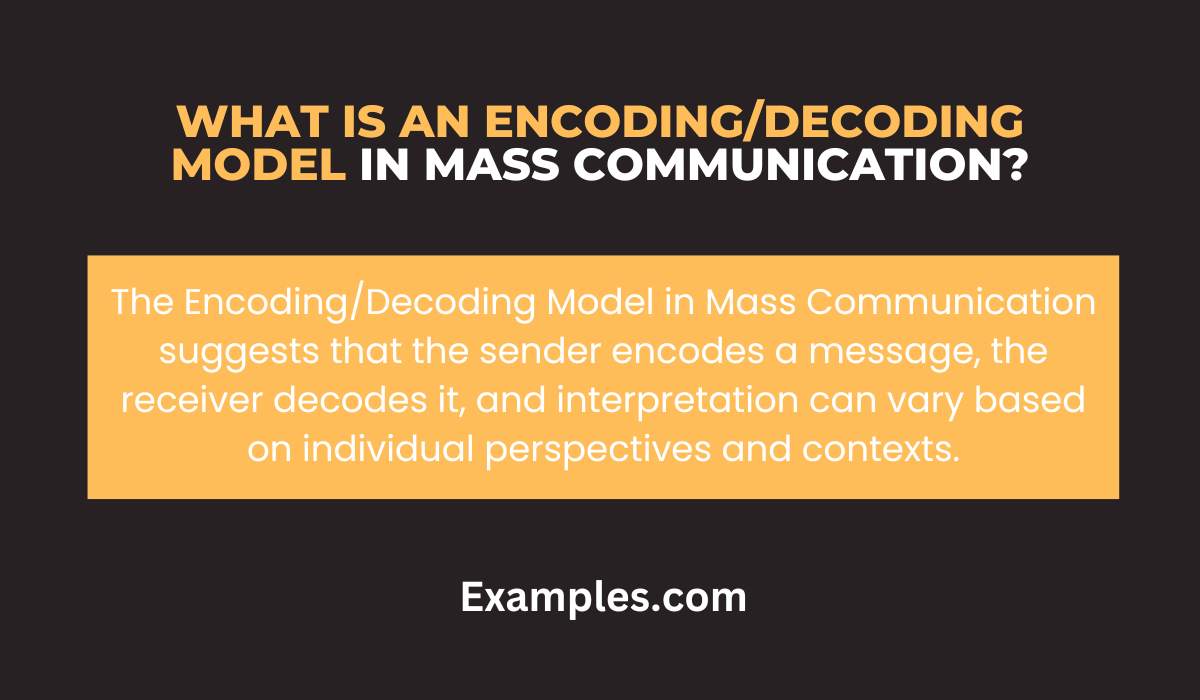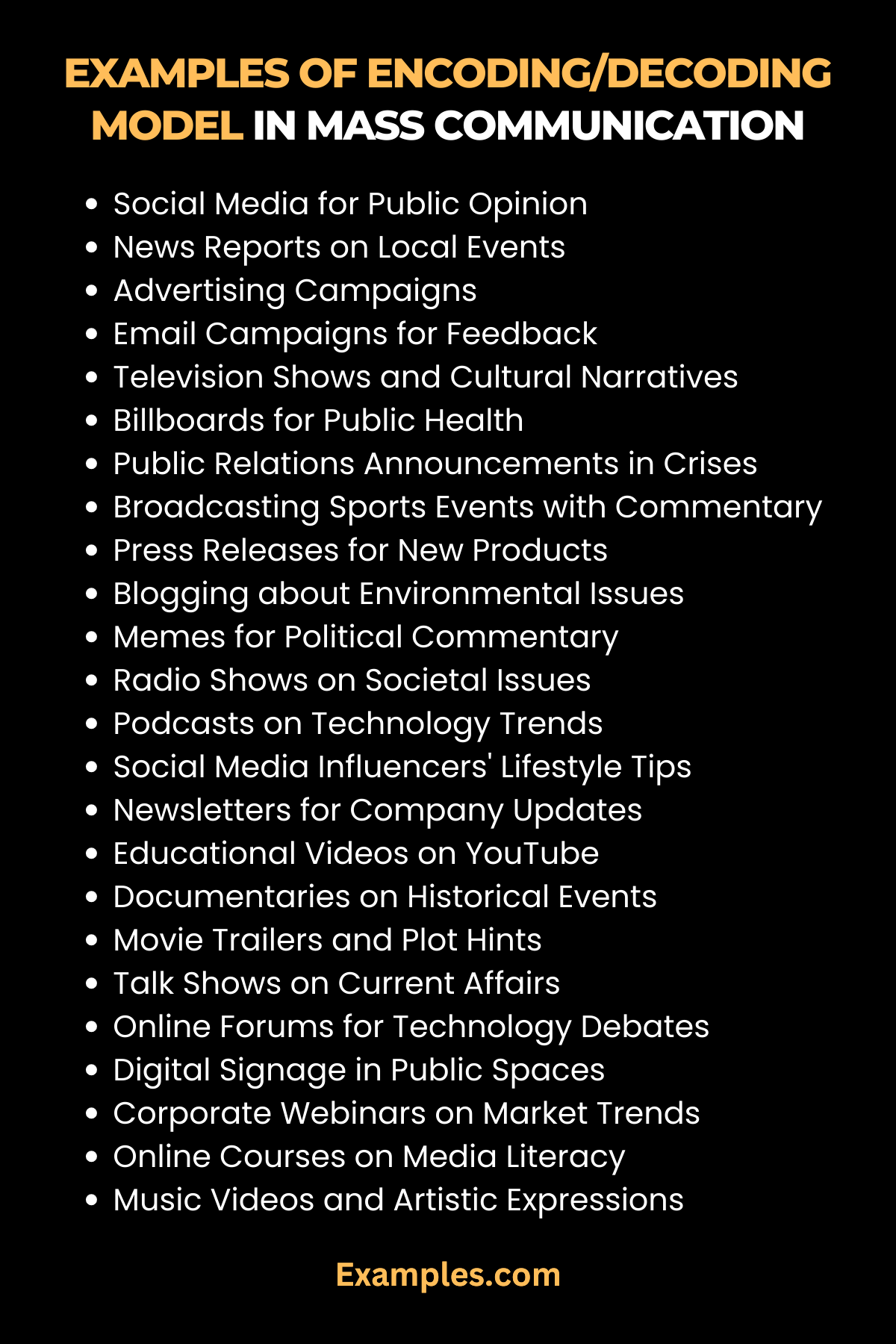29+ Encoding/Decoding Model in Mass Communication Examples
In the dynamic field of Mass Communication, understanding the Encoding/Decoding Model is essential. This comprehensive guide offers in-depth insights into how messages are crafted and interpreted within various media. It provides real-life examples, illustrating the model’s application in today’s media landscape. Whether you’re a student, educator, or media professional, this guide is a valuable resource for grasping the complexities of communication in the digital age.
What is an Encoding/Decoding Model in Mass Communication?
The Encoding/Decoding Model is a fundamental concept in Mass Communication. It describes the process by which a sender (encoder) creates a message and a receiver (decoder) interprets it. This model highlights the importance of context and individual perception in understanding media messages. It’s crucial for analyzing how audiences interpret media content, from news broadcasts to social media posts. Understanding this model is key for professionals in journalism, advertising, and public relations, offering insights into effective communication strategies.

History
The Encoding/Decoding model was developed by Stuart Hall in 1973. It marked a significant shift in mass communication theory, moving away from the notion of a passive audience to recognizing the active role of the audience in interpreting messages. Hall’s model highlighted the complex process of communication, emphasizing that the meaning is not fixed but is constructed by both the sender and receiver.
What is the Best Example of Encoding/Decoding Model in Mass Communication
The Encoding/Decoding Model, introduced by Stuart Hall in the 1970s, is a cornerstone in understanding how mass communication operates. One of the best examples illustrating this model is a television news broadcast.
In this scenario, the news channel (encoder) constructs a news report based on a current event. The process of encoding involves choosing specific words, images, and narratives to present the story. This encoding is influenced by the channel’s own cultural beliefs, values, and intentions, often reflecting a particular viewpoint or agenda.
The audience (decoder) receives this news broadcast, but each member interprets it based on their own cultural background, beliefs, and experiences. This decoding process means that the same news story can be understood in multiple ways by different viewers. For instance, a political news story might be interpreted as unbiased by some, while others might see it as favoring a particular political stance.
This example demonstrates how messages in mass communication are not just passively received but actively interpreted, leading to diverse understandings and reactions among the audience.

30 Examples of Encoding/Decoding Model in Mass Communication
Encoding/Decoding Model in Mass Communication: Explore how messages are created, conveyed, and interpreted in various media. This approach is crucial in understanding the dynamics of communication, particularly in the realms of journalism, advertising, and digital media. It highlights the active role of audiences in interpreting messages, shaping mass communication strategies, and influencing media content.

- Using social media to gauge public opinion: A brand encodes a message in a tweet, and the audience decodes it, leading to varied interpretations and feedback.
- Creating a news report on a local event: Journalists encode information and context, which viewers decode based on their understanding and biases.
- Launching an advertising campaign: The ad’s message is encoded with persuasive intent, decoded differently by diverse audiences.
- Email campaigns for customer feedback: Each email is encoded to seek responses, decoded by customers to provide feedback.
- Television shows portraying cultural narratives: Shows encode cultural values, decoded by audiences in the context of their own cultures.
- Billboards promoting public health messages: The simplicity in encoding allows for immediate decoding and understanding by a wide audience.
- Public relations announcements during crises: PR teams encode carefully crafted messages, decoded under public scrutiny.
- Broadcasting sports events with commentary: The commentary encodes insights, decoded by fans with varying levels of understanding.
- Printing press releases for new products: Press releases encode product information, decoded by journalists and customers.
- Blogging about environmental issues: Blogs encode personal perspectives, inviting diverse decodings from readers.
- Using memes for political commentary: Memes encode complex ideas simply, decoded with varied understanding based on viewers’ knowledge.
- Radio shows discussing societal issues: Shows encode perspectives and information, decoded by listeners in personal contexts.
- Podcasts on technology trends: Podcasts encode expert insights, decoded by a tech-savvy audience.
- Social media influencers sharing lifestyle tips: Influencers encode personal experiences, decoded by followers in their contexts.
- Newsletters updating company progress: Newsletters encode company achievements, decoded by stakeholders.
- Educational videos on YouTube: Videos encode educational content, decoded by students with different learning paces.
- Documentaries presenting historical events: Documentaries encode interpretations of events, decoded by audiences with varied historical knowledge.
- Movie trailers hinting at plotlines: Trailers encode key scenes, decoded by audiences forming expectations.
- Talk shows discussing current affairs: Hosts encode opinions, decoded by viewers with their own biases.
- Online forums debating technology advancements: Posts encode personal opinions, decoded by members with different tech backgrounds.
- Digital signage in public spaces: Signage encodes brief messages, quickly decoded by passersby.
- Corporate webinars on market trends: Webinars encode in-depth analysis, decoded by professionals in the field.
- Online courses on media literacy: Courses encode educational content, decoded by learners at various levels.
- Music videos conveying artistic expressions: Videos encode symbolic elements, decoded by viewers interpreting artistic intent.
- eBooks on mass communication theories: eBooks encode complex theories, decoded by students and scholars.
- Virtual reality experiences in education: VR encodes immersive learning experiences, decoded uniquely by each user.
- Augmented reality in advertising: AR ads encode interactive elements, decoded through user interaction.
- Text messages for customer service: Messages encode concise information, decoded by customers seeking assistance.
- Interactive kiosks in shopping malls: Kiosks encode user-friendly information, decoded by shoppers.
- Infographics on social issues: Infographics encode data visually, making it easily decoded for quick comprehension.
Role of Encoding/Decoding Model in Mass Communication
- Understanding Audience Interpretation: The model emphasizes that the audience is not a blank slate but brings its own frame of reference to the communication process. This understanding is crucial in fields like Public Relations Mass Communication and Journalism Mass Communication.
- Cultural Context: It recognizes the importance of cultural context in communication. Messages are encoded with cultural values and decoded based on the audience’s cultural background.
- Media Strategy Development: For professionals involved in Mass Communication Jobs/Careers, understanding this model is key to developing effective media strategies that consider diverse audience interpretations.
- Challenging Media Dominance: The model provides a framework for challenging dominant media messages and acknowledging minority interpretations.
- Enhancing Media Literacy: It is instrumental in media education, helping students and practitioners understand how media messages are constructed and interpreted.
- Adapting to Digital Media: In the age of digital and Social media Mass Communication, understanding encoding/decoding helps in tailoring content for diverse online communities.
- Impact on Policy Making: The model influences policy-making in media regulation, emphasizing the need for diverse and inclusive media representations.
- Research and Analysis: It offers a theoretical framework for researchers to analyze how media messages are created and received in different socio-cultural contexts.
Importance of Encoding/Decoding Model in Mass Communication
The Encoding/Decoding model is a cornerstone in understanding Mass Communication. It emphasizes the active role of the audience in interpreting media messages. This model, developed by Stuart Hall, delineates how media messages are produced (encoded) and interpreted (decoded) differently by audiences based on their cultural backgrounds and experiences.
Key Aspects of the Encoding/Decoding Model:
- Creation of Message (Encoding): The process where creators encode their messages with specific meanings, influenced by their beliefs, values, and intentions.
- Transmission of Message: The message is then transmitted through various media channels, reaching diverse audiences.
- Interpretation of Message (Decoding): Audiences decode these messages based on their socio-cultural context, leading to varied interpretations.
Importance in Today’s Media Landscape:
- Cultural Sensitivity: It helps media creators understand the diverse ways audiences might interpret their messages, promoting culturally sensitive content creation.
- Targeted Communication: By understanding different decoding scenarios, communicators can tailor their messages to specific audiences more effectively.
- Media Literacy: It fosters media literacy among audiences, encouraging critical thinking about media content.
How to Use Encoding/Decoding Model in Mass Communication
Implementing the Encoding/Decoding model in mass communication involves a deep understanding of both the message creation process and audience interpretation. Here’s how to effectively use this model:
Steps for Effective Use:
- Identify Audience Segments: Recognize and understand the different audience segments and their cultural contexts.
- Tailor Messages Accordingly: Encode messages that resonate with these diverse groups, considering their potential decoding processes.
- Feedback Loop: Establish channels for audience feedback to understand how messages are decoded and make necessary adjustments.
Tips for Practitioners:
- Research Audience Backgrounds: Conduct thorough research on the socio-cultural backgrounds of your audience.
- Diverse Team Involvement: Involve a diverse team in the message creation process to ensure a wide range of perspectives.
- Continuous Learning: Stay updated with changes in audience perceptions and media trends to adapt your encoding strategies.
Examples in Practice:
- Advertising Campaigns: Crafting campaigns that consider cultural nuances to ensure the intended message is conveyed and well-received.
- News Reporting: Presenting news in a way that is mindful of different audience interpretations to avoid miscommunication and bias.
- Public Relations Strategies: Designing PR campaigns that anticipate various stakeholder reactions, enhancing effectiveness and reducing misinterpretations.
Understanding and applying the Encoding/Decoding Model in Mass Communication is crucial for effective message delivery and audience engagement. This guide offers insights into tailoring communications that resonate with diverse audiences, ensuring messages are accurately conveyed and interpreted in the complex landscape of modern media.



